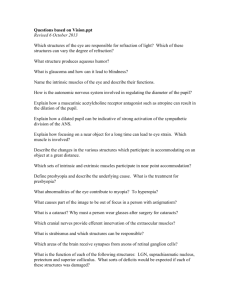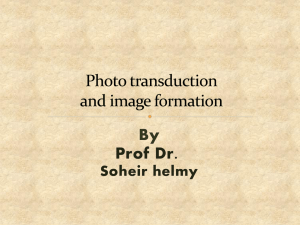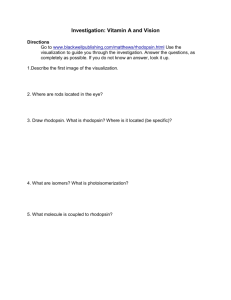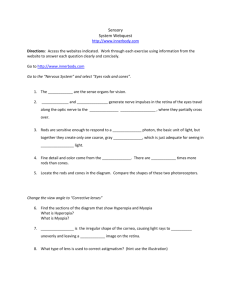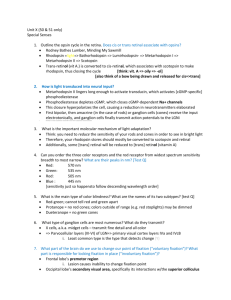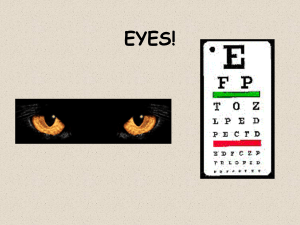Physiology 50 [5-11
advertisement
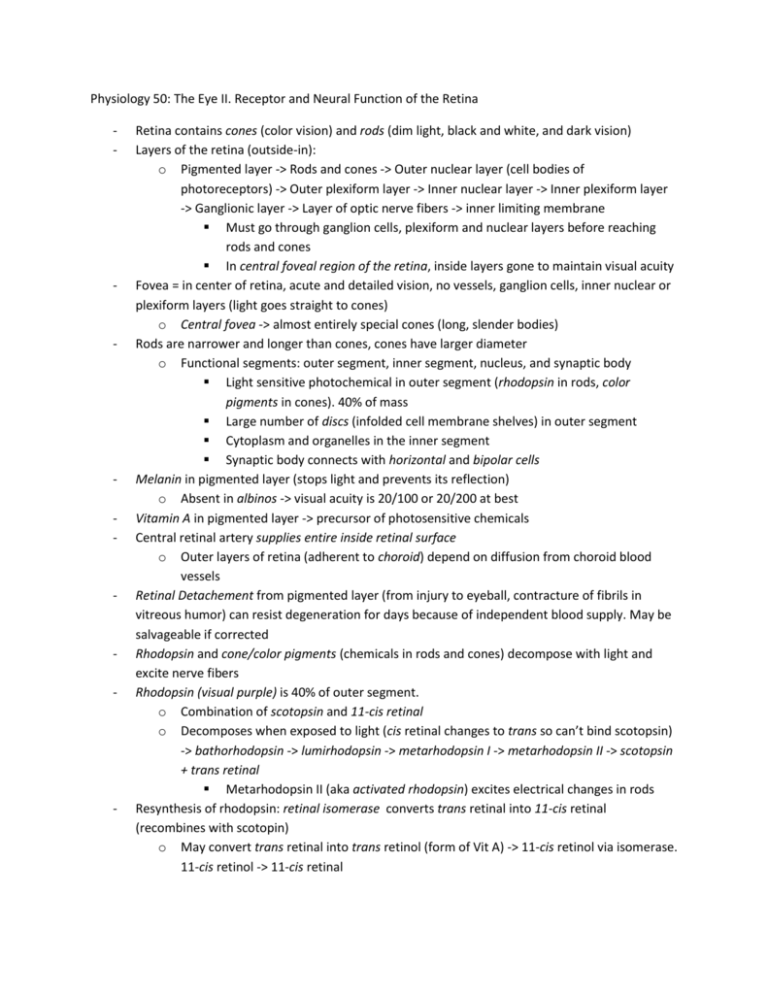
Physiology 50: The Eye II. Receptor and Neural Function of the Retina - - - - - - - Retina contains cones (color vision) and rods (dim light, black and white, and dark vision) Layers of the retina (outside-in): o Pigmented layer -> Rods and cones -> Outer nuclear layer (cell bodies of photoreceptors) -> Outer plexiform layer -> Inner nuclear layer -> Inner plexiform layer -> Ganglionic layer -> Layer of optic nerve fibers -> inner limiting membrane Must go through ganglion cells, plexiform and nuclear layers before reaching rods and cones In central foveal region of the retina, inside layers gone to maintain visual acuity Fovea = in center of retina, acute and detailed vision, no vessels, ganglion cells, inner nuclear or plexiform layers (light goes straight to cones) o Central fovea -> almost entirely special cones (long, slender bodies) Rods are narrower and longer than cones, cones have larger diameter o Functional segments: outer segment, inner segment, nucleus, and synaptic body Light sensitive photochemical in outer segment (rhodopsin in rods, color pigments in cones). 40% of mass Large number of discs (infolded cell membrane shelves) in outer segment Cytoplasm and organelles in the inner segment Synaptic body connects with horizontal and bipolar cells Melanin in pigmented layer (stops light and prevents its reflection) o Absent in albinos -> visual acuity is 20/100 or 20/200 at best Vitamin A in pigmented layer -> precursor of photosensitive chemicals Central retinal artery supplies entire inside retinal surface o Outer layers of retina (adherent to choroid) depend on diffusion from choroid blood vessels Retinal Detachement from pigmented layer (from injury to eyeball, contracture of fibrils in vitreous humor) can resist degeneration for days because of independent blood supply. May be salvageable if corrected Rhodopsin and cone/color pigments (chemicals in rods and cones) decompose with light and excite nerve fibers Rhodopsin (visual purple) is 40% of outer segment. o Combination of scotopsin and 11-cis retinal o Decomposes when exposed to light (cis retinal changes to trans so can’t bind scotopsin) -> bathorhodopsin -> lumirhodopsin -> metarhodopsin I -> metarhodopsin II -> scotopsin + trans retinal Metarhodopsin II (aka activated rhodopsin) excites electrical changes in rods Resynthesis of rhodopsin: retinal isomerase converts trans retinal into 11-cis retinal (recombines with scotopin) o May convert trans retinal into trans retinol (form of Vit A) -> 11-cis retinol via isomerase. 11-cis retinol -> 11-cis retinal o - - - - - - Vit. A is in cytoplasm of rods and pigment layer to form rhodopsin. Excess retinal is converted back to Vit. A Severe vit. A deficiency = night blindness. Must be deficient for months because large amt of vit A stored in liver. Excitation of the rod causes increased negativity (hyperpolarization) to -70 or -80mV rather than depolarization. Decomposition of rhodopsin decreases rod membrane conductance for Na ions o Na/K ATP pump takes Na out and K in and K leaks out via K-channels (inner segment). In dark state, outer segment is leaky to Na using cGMP-gated channels neutralizing negativity (-40mV). cGMP is high in the dark. Degradation of rhodopsin closes Na-cGMP channels. Activated rhodopsin stimulates transducin -> activates cGMP phosphodiesterase (breaks down cGMP to 5’-cGMP) closing Na channels. Rhodopsin kinase inactivates activated rhodopsin reversing the closed channels state. Cones receptor potential is 4 times faster than rods. o Receptor potential is proportional to logarithm of light intensity (allows for light intensity discrimination) 30 photons of light will cause half saturation of the rod due to the amplification of the chemical cascade (hence whey they are activated in the dark) o Cones are 30-300 times less sensitive Photopsins in cones are different from scotopsin of the rods, but retinal is the same. o blue-sensitive, green-sensitive, and red-sensitive pigments (wavelengths = 445, 535, and 570 nm, respectively) Rhodopsin from rods peaks at 505 nm Light adaptation = bright light exposure for hours reduces photochemicals (to retinal and opsins) and converts retinal to vit A (light sensitivity reduced) Dark adaptation = retinal and opsins converted back into light-sensitive pigments and vit A back to retinal (light sensitivity increased) o Dark adaptation curve -> cone adaptation is 4x as rapid as rod adaptation but cease to adapt after few mins whereas rods continue to adapt (more sensitive). 100+ rods summate onto single ganglion as well. Change in pupillary size helps adapt eye to light and dark Neural adaptation = signals are intense with first increase in light intensity (decrease rapidly subsequently) Retinal adaptation to light and dark important to be able to distinguish dark and light spots in an image Interpretation of color is based on the degree of stimulation an image has on the three cones and their ratio to one another. Nervous system interprets set of ratios as a color o Red:green:blue -> 83:83:0 = yellow, 99:42:0 = orange, 0:0:97 = blue, 31:67:36 = green o Equal stimulation of red, green and blue = white (combo of all wavelengths) - - - - - - - - Red-green color blindness = if either red or green cones is missing, can’t distinguish between colors within their spectrum (525-675); X-linked genetic disorder in males (from mother who is color blindness carrier) o loss of red cones = protanope (visual spectrum shortened) o loss of green cones = deutranope (normal visual spectrum) Blue weakness = underrepresented blue cones Use color test charts (spot or Ishihara charts) to rapidly test color blindness/weakness Neuronal cell types: o Photoreceptors (rods and cones) -> send signals to outer plexiform layer, synapsing with bipolar and horizontal cells o Horizontal cells -> signal horizontally in outer plexiform layer o Bipolar cells -> signal vertically to inner plexiform layer, synapsing with ganglion and amacrine cells o Amacrine cells -> signal from bipolar cell to ganglion cell or horizontally within inner plexiform layer o Ganglion cells -> output signals from retina through optic nerve o Interplexiform cell -> signal in retrograde direction from inner to outer plexiform layer (inhibitory controlling lateral spread) Neurons and nerve fibers conducting visual signals for cone vision are larger than for rod vision (much more rapid) o Foveal portion of retina = new, fast cone system. Direct path of cones -> bipolar cells -> ganglion cells (horizontal and amacrine cells transmit inhibitory signals laterally in outer and inner plexiform layer respectively) o Pure rod vision = old rod system. Direct path of rods -> bipolar cells -> amacrine cells -> ganglion cells (with horizontal and amacrine cell lateral connectivity) Both rods and cones release glutamate as neurotransmitter; amacrine cells secret 8 types of NT (include GABA, glycine, dopamine, Ach, and indolamine -> all inhibitory) Ganglion cells are the only ones using action potential. All others use electrotonic conduction = direct flow of current o Allows for graded conduction of signal strength (not all or none) Outputs of horizontal cells are always inhibitory -> ensure transmission of visual pattern with proper contrast with lateral inhibition o Amacrine cells provide additional lateral inhibition Depolarizing v. hyperpolarizing bipolar cells -> one depolarizes in response to glutamate and the other hyperpolarizes or on gets direct excitation from rods/cones and the other indirectly through horizontal cells o ½ transmit + signals and ½ transmit – signals (more lateral inhibition) 30 types of amacrine cells. One type for direct path of rod vision. Another responds at onset of visual signal, another at offset, another with light is turned on or off, another to movement of a spot across the retina (directional sensitive). 60 rods and 2 cones converge on each ganglion cell. o - - In central fovea, only slender cones and no rods. 1:1 ratio of cone to ganglion cell (high visual acuity) o Peripheral retina -> higher sensitivity to weak light. 200:1 ratio of rod to ganglion cell (summate to give more intense stimulation) Ganglion cells = W, X, Y cells o W cells (40%) = small, slow velocity, most excitation from rods (bipolar and amacrine cells), dendrites spread wide. Detect directional movement in visual field (crude rod vision in dark) o X cells (55%) = medium, fast velocity, small fields. Signals discrete retinal location of fine detail. All color vision. o Y cells (5%) = large, faster velocity, dendrites spread wide. Detect rapid change in visual image without accuracy to location Ganglion cells transmit continuous, spontaneous impulses at various rates o Excited by changes in light intensity (one may respond to light turning off while the other to light turning on due to lateral inhibition from amacrine cells) o Respond to contrast borders Direct signals from photoreceptors on depolarizing bipolar cells (excitatory) are neutralized by lateral signals from hyperpolarizing bipolar cells (inhibitory) with flat light. In contrast light, not neutralized. o Stimulate by several or only 1 cone. If all 3 types of cones stimulate same ganglion cell = “white” signal. May be stimulated by one color and inhibited by another (red and green, or blue and yellow). * Color analysis begins in the retina
